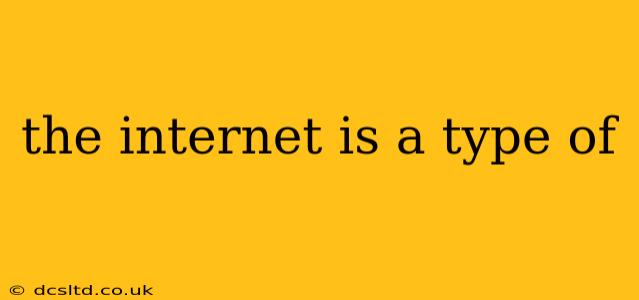The Internet: A Type of Global Network
The internet is a type of global network connecting billions of devices worldwide. It's not just one thing, but rather a vast, interconnected system of networks using standardized communication protocols. To understand its nature more fully, let's delve into what makes it so unique and powerful.
What exactly is the internet?
The internet is a decentralized, global network of interconnected computer networks. It uses a suite of networking protocols, most notably TCP/IP (Transmission Control Protocol/Internet Protocol), to allow different networks to communicate with each other seamlessly. This means that a computer in Tokyo can exchange data with a computer in New York City without needing specialized connections between those two locations – the data travels across many intermediary networks.
Think of it like a massive road system: the internet is the overall highway system, and individual networks (like your home Wi-Fi or your mobile carrier's network) are like individual roads feeding into it. Each road may have its own rules and regulations, but the overall system allows for consistent travel from one point to another.
Is the internet a WAN or LAN?
This question often arises, and the answer is that the internet itself is a Wide Area Network (WAN). A LAN (Local Area Network) is a network confined to a small geographical area, like a home, office, or school. The internet, spanning the entire globe, is vastly larger and far more complex than any single LAN. Individual LANs connect to the internet, but the internet itself isn't a LAN; it's the collection of countless WANs and LANs working together.
What are the key components of the internet?
Several key components make the internet function:
- Servers: These are powerful computers that store and distribute information. Websites, email, and many other online services rely on servers.
- Clients: These are devices (computers, smartphones, tablets, etc.) that access and use the information stored on servers.
- Routers: These are devices that direct data packets between networks, ensuring information reaches its intended destination.
- Communication Protocols (TCP/IP): This is the set of rules that governs how data is transmitted and received across the internet.
- Network Access Points (NAPs): These are major interconnection points where different networks connect to each other.
What's the difference between the internet and the World Wide Web?
Many people use the terms “internet” and “World Wide Web” (WWW) interchangeably, but they are different. The internet is the underlying infrastructure, the network itself. The World Wide Web is a service that runs on the internet. It's a system of interlinked hypertext documents accessed via web browsers like Chrome or Firefox. You can think of the internet as the roads and the World Wide Web as the cars using those roads to reach specific destinations (websites).
In short, the internet is a global, interconnected network that enables communication and data exchange across the world. Its decentralized nature, standardized protocols, and ever-expanding scope continue to shape our lives in profound ways.
